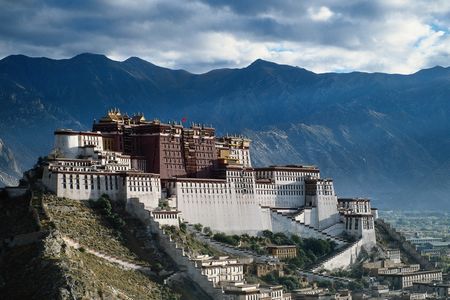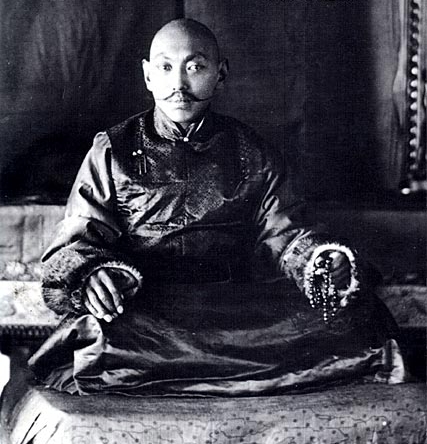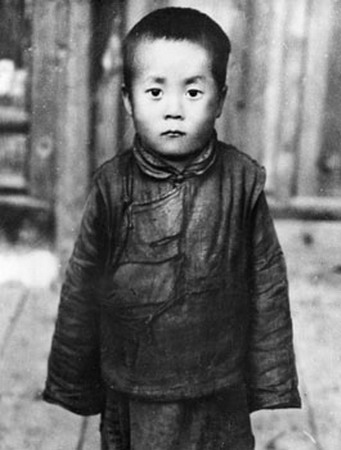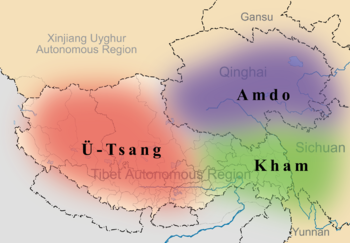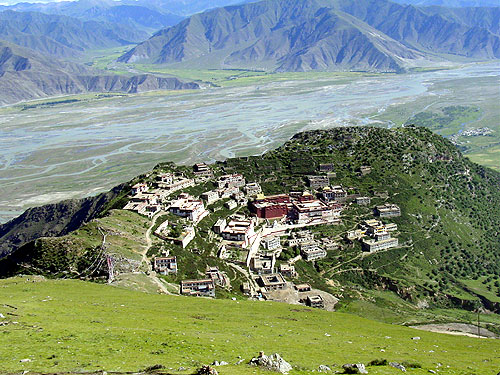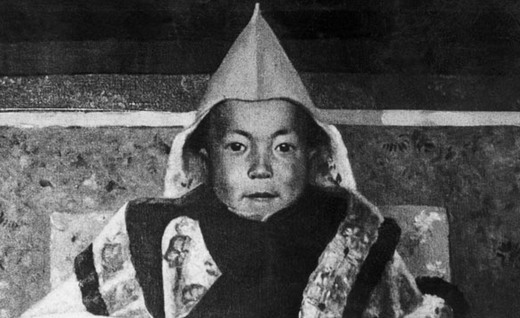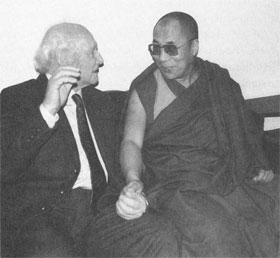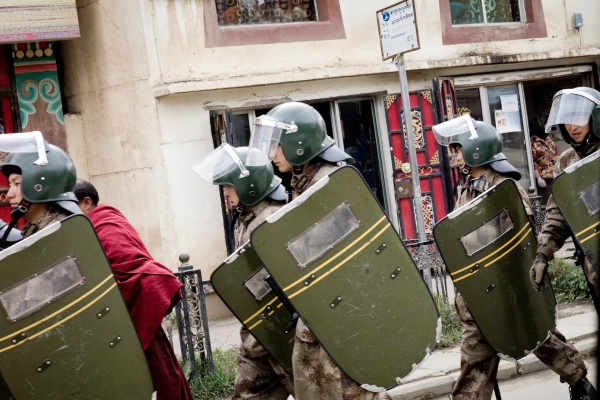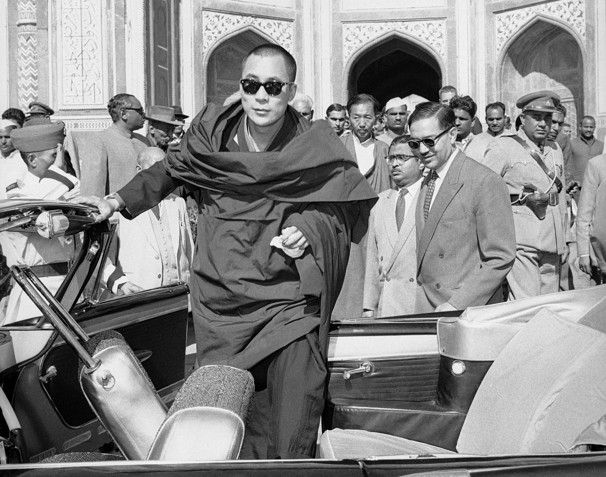What is a Dalai Lama?
After Buddhism spread to Tibet from India in the seventh century, four main sects were formed – the Kagyu, the Nyingma, the Sakya, and the Gelukpa. They were all based on dharma, the teachings of Buddha. The Gelukpa sect would be the one to establish a relationship with Mongolia and, as a result, become the most influential sect in the future.
In Tibet, a lama was a Buddhist teacher who instructed others in Buddhist philosophy. The title “Dalai Lama” arose in the sixteenth century, when Altan Khan, the ruler of Mongolia, invited the third Gelukpa lama, Sonam Gyatso, to instruct Mongols in Buddhism. Khan was so moved by the lama’s teachings that he made Buddhism the law in Mongolia and gave Sonam Gyatso the title “Dalai Lama,” which is a combination of the Mongolian word for ocean and the Tibetan word for teacher. This title roughly translates as “Ocean of Wisdom.”
Ancient wall mural of the 5th Dalai Lama
The Dalai Lama is believed to be the reincarnation of Chenrezig, the deity of compassion who helps all beings try to escape the suffering of life. Every time one reincarnation dies, a young boy is usually found within the span of a few years, identified as the new Dalai Lama, and subsequently raised and taught as Tibet’s next religious leader. As of today, there have been fourteen Dalai Lamas.
Rise of the New Lama
The Portala palace in Lhasa
After Sonam Gyatso had passed away and his successor, the fourth Dalai Lama, was named, Tibet had many conflicts between religious sects, with different beliefs and small rulers looking to gain power. During that time the Gelukpa sect was still maintaining contact with Mongolia and would continue to do so until the twentieth century. In the life of the fifth Dalai Lama, the Mongolian prince Gushi Khan invaded Tibet, declared himself king, eliminated all opposition of the Gelukpa sect, and assigned control of the country to the Dalai Lama. Also known as the "Great Fifth," the fifth Dalai Lama would demonstrate his power by organizing the federal government and authorities of Tibet, moving his seat of power to the capital Lhasa, and starting construction on the great Potala Palace. However, subsequent lamas would not have this power. In fact, the sixth Dalai Lama was declared a false incarnation and sent into exile because he spent more time drinking chang (a potent wine) and courting women than he did studying Buddhism. The subsequent Dalai Lamas were either murdered, died in their childhood, or were puppets of power-seeking ministers.
The 13th Dalai Lama
The thirteenth Dalai Lama, Thubten Gyatso, was very different from his predecessors. He recognized that there were faults in the Tibetan government and tried to rectify them. He also realized that Tibet, being isolated so long from the outside world, was vulnerable to internal and external attacks. As a result, he began building an army, sending children overseas to have a Western education, and introducing technology to Tibet by bringing the first electric generator and cars to Lhasa. When the Manchu dynasty fell in 1911, he severed all relations with China and declared Tibet as an independent country, knowing that the relationship maintained between the Gelukpa sect and the Mongols and later the Manchus was now lost in the face of the new Chinese government. Therefore, when he died in 1933, political intrigue and arguments were stirred up over who would be the new leader. Within this recent turmoil of increasing power plays and conflict came the need to find the next reincarnation of Chenrezig – the fourteenth Dalai Lama.
Read More:
Details on Past Dalai Lamas
A Leader is Born
The 14th Dalai Lama, Lhamo Thonddup, as a child
On July 6, 1935, a small boy was born in the small village of Takster, found in the Amdo region of northeastern Tibet. He was the ninth of sixteen children, seven of whom survived. His name was Lhamo Thondup, or “Wish-Fulfilling Goddess.”
Regions of Tibet
Looking back on that day, people recall the thundering weather and the rainbow over the house during his birth, a pair of crows on the roof, and the unexpected recovery of his father Choekyong Tsering, who had been sick for weeks. All of these signs are indicative of the birth of a remarkable child.
When the boy was old enough, he helped his mother, Deylei Tsering, with household chores. His father farmed, raised animals, bartered for what the family couldn’t grow, and traded for horses. His mother was known for her deep compassion, a trait that also revealed itself in her son. Two of Lhamo Thondup’s older brothers were away studying at the nearby Kumbum Monastary, one of whom was recognized as the reincarnation of a Buddhist teacher. As he grew older, there were also signs that he was the reincarnation of the Dalai Lama: he liked to pretend he was packing for a trip to Lhasa; he would insist on sitting at the head of the table; and he had a few dreams that could have been interpreted as signs. However, nothing definitively indicated what was to come.
The Search
Two years before Lhamo Thondup’s birth, the thirteenth Dalai Lama died. Hoping to restore at least some order to Tibet, lamas began to search for his reincarnation. They had some signs as to where they should look: There were elephant-shaped cloud formations in the northeastern part of the sky. There was a star-shaped fungus on a column at the northeastern part of the temple, which was built to entomb the thirteenth Dalai Lama. The face of the late Dalai Lama, which was originally positioned to the south on his tomb, had later turned to the east.
These signs indicated that the eastern part of Tibet was important. In addition the regent, or the temporary Tibetan Buddhist leader appointed at the time, had seen visions that would later help in the search. Armed with this information, lamas headed out in parties to look for the reincarnation of the Dalai Lama.
Landscape of Tibet
After three months of travel, a group of lamas came to the Kumbum Monastary and immediately recognized it as the monastery from the regent’s visions. After paying tribute to the local Chinese governor Ma Pu-Feng, the search party visited the home of Lhamo Thondup. Pretending to be lost travelers, the lamas were welcomed into the house, where Lhamo Thondup showed signs of being the reincarnation of the Dalai Lama by identifying the lamas. After the lamas had left, they contacted the Tibetan government for permission to examine him and, upon receiving it, went back to the home and gave the boy a simple test – to distinguish the possessions of the late Dalai Lama from other objects. Lhamo Thondup passed the test. The lamas had found their reincarnation.
There was still the problem of getting him to Lhasa, the Tibetan capital. Ma Pu-Feng had heard what was happening and had demanded a large amount of money from the Tibetans. After he received the money, he then demanded an even larger sum, effectively delaying the departure of Lhamo Thondup for about two years. Meanwhile, the boy stayed at the Kumbum Monastery with his two older brothers.
In the summer of 1939, the fourteeth Dalai Lama finally departed for Lhasa at the age of four years old.
His initiation
The 14th Dalai Lama at his initiation
In Lhasa, Lhamo Thondup was officially proclaimed the fourteenth Dalai Lama by the Tibetan government and ceremoniously initiated on the Lion Throne, the symbol of Tibetan political and spiritual leadership. His hair was shaved and, as tradition called, he received a new name – Jamphel Ngawang Lobsang Yeshe Tenzin Gyatso. Westerners would come to call him Tenzin Gyatso or His Holiness the Dalai Lama; Tibetans would call him Gyalwa Rinpoche, Yeshi Norbu, or Kundun. The young Dalai Lama was then moved to the Potala Palace, where he would live and study for the rest of his childhood and teenage years.
Every so often the young boy was allowed to visit his family, who had also moved to Lhasa. For the first three years one of his brothers also lived with him in the palace, but because of the mischief they caused together he was sent away to school. Alone, the Dalai Lama turned to other sources of entertainment by taking apart old music boxes and watches and staging battles with other monks using armies made of barley dough. He also often looked down at the city of Lhasa through his telescope – it was through this that he found his love for the people whom he would one day lead.
His Education
The 14th Dalai Lama with his tutor Heinrich Harrer
As the future leader of Tibet, the Dalai Lama had to be thoroughly educated in preparation for his position. Starting at the age of six he learned meditation, reading, writing, Buddhist scriptures, philosophy, logic, and debating, and Tibetan art, culture, and poetry. Being isolated from even his own people, he became more interested in the outside world as he grew older and learned of the hardships of the poor in its feudal society.
Then, in 1949, the Dalai Lama heard of Heinrich Harrer and Peter Aufschnaiter, two Austrians in Lhasa who had been British prisoners in India during World War II and escaped into Tibet. He invited Harrer to tutor him and over the next few years he learned English and of the Western world – the outside world. At the same time the Dalai Lama was beginning to participate in public debates and religious ceremonies as a part of his education. However, he was still too young to be politically active in his country. That would soon change.
The Chinese Take Over
Chinese soldiers in Tibet
In the summer of 1950, a telegram arrived at the Potala Palace from a governor in a southeastern province of Tibet. In it, the governor said that eastern Tibet had been invaded by Chinese Communist soldiers claiming to have come in order to free Tibet from “imperialists” – that is, Westerners living in Tibet. Knowing that Tibet could not defend itself against the Chinese People’s Liberation Army (PLA), an emergency meeting is held by the Tibetan parliament. In October 80,000 more soldiers were sent into Tibet by the PLA in preparation for a full takeover.
The Tibetan people, terrified, unite in prayer and, losing faith in the Tibetan government, turn to the Dalai Lama for leadership. Although traditionally the Dalai Lama only takes up leadership at the age of 18, Tenzin Gyatso was forced to become the political leader of Tibet at the age of 15. Soon afterwards his brother arrived at Lhasa bearing heavy news – the Communists had taken over the Kumbum Monastery. He himself had been imprisoned and released on the condition that he persuade his brother to accept Communist control in Tibet and, if the Dalai Lama refused, to kill him. Quickly at the advice of his brother the Dalai Lama sent out delegations to other countries to ask for their aid, appointed two prime ministers to rule in his place, and moved his seat of power to Yatung in order to escape the encroaching Chinese.
In Yatung, the Dalai Lama continued his studies, but constantly worried about the Chinese invasion. Foreign nations were unwilling to help because they were cautious of provoking China. In addition, the Chinese claimed that Tibet had always been a part of China. Many people believed this, since Tibet had always been so isolated from the rest of the world.
On May 26, 1951, the Dalai Lama was surprised to hear on the radio that a Tibetan delegation had signed a pact with China called the “Seventeen Point Agreement” without his consent. He later discovered that the delegation had been threatened to sign the agreement. This, according to legal experts, made the document invalid. In an attempt to talk directly to the Chinese government, the Dalai Lama reentered Lhasa and tried to negotiate with a Chinese general but failed – instead, he was forced to agree to the Seventeen Point Agreement himself.
In another attempt to negotiate with China, the Dalai Lama accepted an invitation to tour China in 1954 for the entire year. During the tour, a teacher explained the theory behind Communism to him, and he met with Chairman Mao Tse-tung, the communist leader of China. The two got along well, leading the Dalai Lama to believe Tibet could cooperate peacefully with China – but when he returned to his country, his hopes vanished. Chinese soldiers had an even stronger presence in Tibet, destroying monasteries and important Tibetan artifacts, torturing and killing people, and pillaging Tibet’s food storage, which caused high food prices and starvation among Tibetans.
Over the next four years, the situation deteriorated even further. Despite all his efforts, the Dalai Lama knew that the country could soon go into a state of war, and so he arranged to have his final examinations for his education as soon as possible. The year was 1959 – he was 23.
Exile
In the spring of 1959, the Dalai Lama passed his examinations, earning his Geyche degree (similar to a Ph. D) in metaphysics. Soon afterwards, he accepted an invitation to watch a Chinese dance group, which he had previously put on hold due to his studies.
On the day of the event, however, the Dalai Lama and his attendants awoke to 30,000 supporters surrounding the Potala Palace and he was forced to decline the invitation. Despite his refusal, many of the Tibetans did not budge from the outside of the palace.
Over the next week, tensions between the Chinese and Tibetans grew high. Eventually, the Dalai Lama consulted his advisers and his divine oracle, who told him to leave Tibet immediately. After meditating and doing his own divination, the Dalai Lama came to the same conclusion. During the night of March 17, 1959, a few minutes before 10:00 PM, Tenzin Gyatso departed from Lhasa in disguise.









